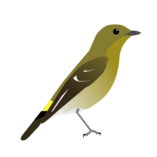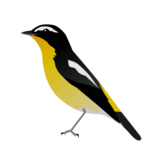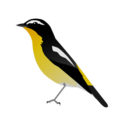Yellow-rumped flycatcher facts for kids
The Yellow-rumped Flycatcher (Ficedula zanthopygia) is a small, colorful bird found in eastern Asia. It's also known as the Korean Flycatcher or Tricolor Flycatcher. This bird is quite special because it doesn't look much like other birds, except for the Narcissus Flycatcher.
Yellow-rumped Flycatchers spend their breeding season in eastern Asia. This includes places like parts of Mongolia, southern China, Korea, and western Japan. When winter comes, they fly south to warmer areas. They can be found in parts of the Malay Peninsula and South Asia during these colder months.
Quick facts for kids Yellow-rumped flycatcher |
|
|---|---|
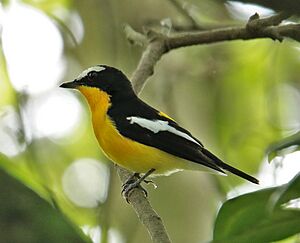 |
|
| Adult male | |
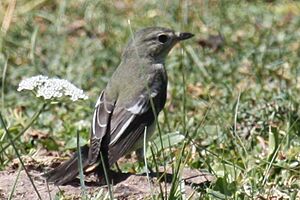 |
|
| Adult female (Mongolia) | |
| Conservation status | |
| Scientific classification | |
| Genus: |
Ficedula
|
| Species: |
zanthopygia
|
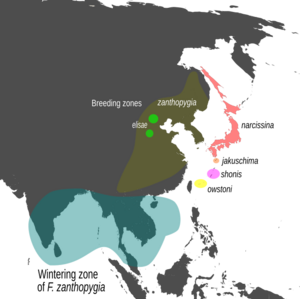 |
|
| Distribution of various Ficedula species (Wintering grounds of F. zanthopygia in blue) | |
| Synonyms | |
|
Xanthopygia tricolor (Hartlaub, 1845) |
|
What Does It Look Like?
One of the easiest ways to spot a Yellow-rumped Flycatcher is its bright yellow rump. This is the area just above its tail. You can see this yellow patch on both male and female birds.
Male Yellow-rumped Flycatchers have black feathers on their upper body. They also have a clear white stripe above their eye, like an eyebrow. This white stripe helps tell them apart from similar birds, like the Narcissus Flycatcher. Males also have a white patch on their wings and bright yellow feathers on their underside.
Female Yellow-rumped Flycatchers and younger males look a bit different. They are more grayish or olive-green on their upper parts. Their tail is a darker, blackish color. They are paler on their underside and also have the yellow rump. Sometimes, females might even have a bit of yellow on their throat.
Where Do They Live?
These flycatchers breed in areas like Manchuria, Korea, and China. They prefer to build their nests in low valleys at the bottom of hills.
Life Cycle and Habits
The nesting season for Yellow-rumped Flycatchers in the Xiaoxingan region usually happens in May and June. The female bird builds the nest all by herself. It takes her about three to four days to finish it.
Once the nest is ready, the female lays about 4 to 7 eggs. She then sits on the eggs to keep them warm, a process called incubation. This takes about 11 to 12 days. The male and female parents work together to find food for their baby chicks. They usually look for food within about 70 meters (230 feet) of their nest. The young birds are ready to fly, or fledge, when they are about 14 to 15 days old.
Yellow-rumped Flycatchers were first noticed spending their winters in central India in 1989. Since then, they have also been found wintering in southwestern India and Sri Lanka.
Images for kids



